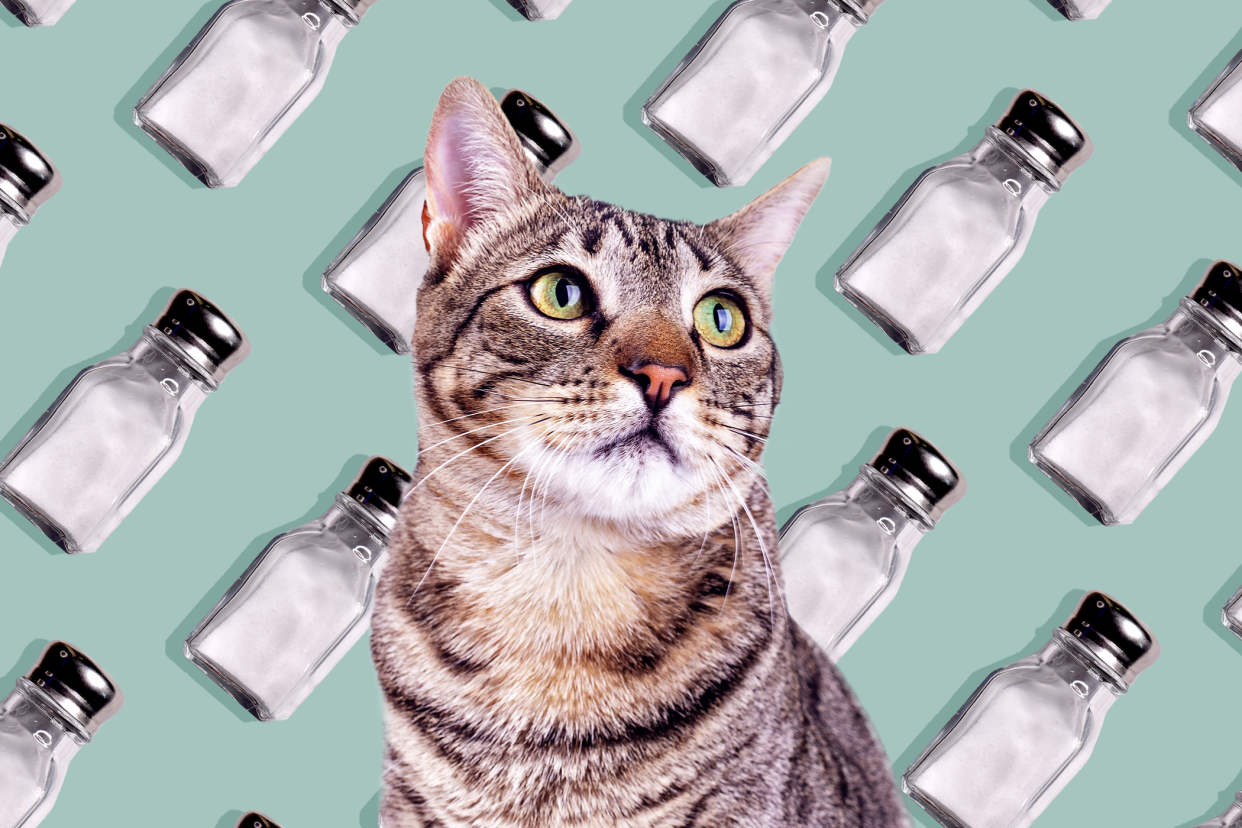Can Cats Have Salt? Veterinarians Weigh In on This Complex Topic

Artem Ledowskikh / Shutterstock / Cris Cantón / Getty
While having table salt is totally normal in most households, it's meant for the humans of the home—not their furry pets. Sprinkling salt on your dinner likely won't set you back health-wise, but you should never place some flakes on your cat's food; they already have the proper amount of salt added to their expertly formulated cat food. However, your curious feline may find unsuspecting sources of salt (lookin' at you, Play-doh!), and could consume more than they can handle. Here, we chatted with veterinarians about the amount of salt kitties need and what to do if you suspect toxicity.
Do Cats Need Salt in Their Diet?
First things first: salt isn't inherently bad. In fact, salt is an essential mineral for life in people and pets, and it's found in blood and the surrounding fluid cells in the body, explains Brian C. Hurley, DVM, national medical director of AmeriVet.
"Appropriate electrolyte balance is important for normal nerve and muscle cell function, maintaining a healthy cellular environment and preventing cell destruction," he says. "In addition, salt aids in the palatability of diets for pets and humans. Diets made for our feline family members incorporate an appropriate level of salt and other minerals, carbohydrates, proteins, fats, and vitamins to ensure proper bodily function."
In other words: pet food makers ensure their ingredients support the level of salt your kitty needs without you having to overthink it. If you're curious, the Association of American Feed Control Officials recommends that for maintenance and to support normal growth and development, dry cat food should contain at least a minimum of 0.2-percent sodium of the total dry matter that your cat eats or 0.5 grams of sodium per 1,000 calories they eat.
RELATED: Can Cats Eat Cheese? It's Complicated
How Much Salt Is Safe for Cats?
Through their normal kibble diet, most cats will receive the salt they need (.5 grams per 1,000 kcal). And while salt may be essential, the balance of salt and water in a cat's body is important, says Adam Currier, DVM, of Fuzzy.com.
"Cats can adapt well to gradual changes in salt levels in their diet. If you are feeding a commercial cat food, then you probably don't need to be concerned about your cat having a problem with salt levels," he says.
Generally speaking, healthy cats do not require a low- or reduced-sodium diet and can pass excess sodium from their diet in their urine, explains Michelle Dulake, DVM, CEO of Fera Pet Organics. In some cases, a vet may recommend decreasing your cat's sodium intake to decrease high blood pressure or if there is kidney, liver, or heart disease, she notes.
What To Do If Your Cat Eats Salt
Think about licking some salt off your finger. Now, think about having a spoonful. Those experiences are vastly different, and it's an easy way to visualize how much salt is too much for your cat. Currier says that licking some salt or having food with a few sprinkles probably won't cause a problem. However, sudden exposure to a lot of salt at once, or a high-salt food like potato chips or pickles, can be very serious. "Anything over one gram of salt per two pounds of body weight is cause for concern," he warns.
To put this into perspective, for most cats, this would mean eating four or more grams of salt at once, which is about 3/4 of a teaspoon of table salt. Currier says if your cat has eaten very salty or brined food, you should contact your veterinarian or the ASPCA Poison Control Center at (888) 426-4435. "Be sure to have the package available so that the amount of salt eaten can be calculated," he adds.
RELATED: 9 Human Foods That Are Safe for Kitty to Snack On
Symptoms of Salt Toxicity in Cats
If your kitty got into a salty-something without your knowledge, it can be difficult to determine the exact amount of salt they ate. Try your best to look out for the signs of salt toxicity. Currier says you'll see changes in water intake and urine volume as well as vomiting, diarrhea, drinking a lot of water, muscle weakness, muscle twitching, rapid heartbeat, seizures, disorientation, behavior changes, coma, and even death in some cases. "These symptoms can start anywhere from a few minutes to a few hours after consuming the salt," he adds.
RELATED: 15 Toxic Human Foods You Should Never Feed Your Cat
Treatment of Salt Poisoning/Toxicity in Cats
If your kitty is demonstrating these salt toxicity signs, your veterinarian will come up with a treatment plan. In mild cases with no vomiting, Hurley says you can offer your pet small amounts of fresh water at frequent intervals.
In cases of overdose, your veterinarian will want to perform a complete physical examination and will likely recommend bloodwork to assess salt levels. "Treatment requires hospitalization, IV fluids, treating for nausea or vomiting, and monitoring electrolyte levels to ensure normal electrolyte balances have been re-established," he continues. "If seizures are present, anti-seizure medication may be warranted."

